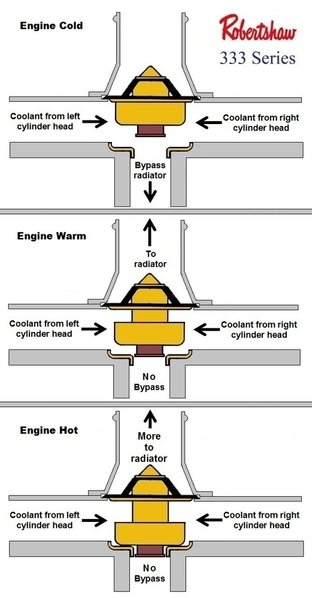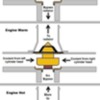Nice illustration! If the thermostat does not open enough to block the restrictor plate completely then I understand the engine will eventually overheat however will the coolant flowing through the coolant tubes, radiator, and tanks read normal temps or should that coolant temp become overheated as well?
If thermostat did open, but not enough to block recirc, I would think the outlet to the tank and TO radiator would be as HOT.
I don't have any experiance, but from a classroom heat transfer view, I would think the metal heads have to be hotter than the coolant
Attachments
Lets review the basics. Perhaps there's something you've overlooked.
The 351 Cleveland has been one of the most often over-heated engines on the road. This is not a defect but a problem created MOSTLY BUT NOT ENTIRELY by parts vendors. You have the proper thermostat and the brass restrictor … so lets not dwell on an area you already have covered. A third source of trouble is aftermarket coolant pumps, some of them have the recirc passage blocked. The passage is there, but out of the box they don't allow recirculation, until the buyer drills-out the passage. This causes problems during warm-up because the coolant can't flow through the engine block, indicated by a pulsing temperature gage needle. Finally, home mechanics assemble the engine with the head gaskets improperly oriented, which blocks the coolant outlet in the cylinder head, thus there's no coolant circulation in whichever side of the engine has a misoriented gasket. This creates a tell-tale gurgle and surge sound emanating from the water jacket. The lower rear corners of the head gaskets are cut-off, the lower front corners are not. If properly oriented the front corners of both head gaskets should be visible poking out from between the heads and block in the front of the engine.
The Pantera has two cooling system problems: insufficient flow at low rpm and air collecting in the radiator.
There are four steps to take to improve coolant flow in a Pantera. (1) First step, utilize a radiator with a low-restriction core design. (2) Second step, utilize the coolant pump sold by Flow Kooler (p.n. 1648) which has a billet impeller designed to improve low rpm coolant flow. (3) The third step is to make sure there are no sections of radiator hose between the radiator outlet and the coolant pump inlet that can collapse; all sections of hose should be internally supported with a coiled wire or something similar. Unsupported sections of hose between the radiator and the coolant pump tend to collapse at low rpm or idle (that's the main benefit of the Gates hose often recommended, its too thick and stiff to collapse). AND (4) the fourth step is to utilize a 10% over-drive coolant pump pulley available from SACC Restorations.
The issue of air collecting in the Pantera radiator can be resolved in one of two ways. (1) The simplest way is to install a manual bleed valve (drain petcock) in the top of one of the radiator tanks and develop the habit of regularly bleeding the air from the tank manually. (2) The better way is to revise the coolant recovery tank to perform as a head tank, thus providing a functional place to plumb the radiator vent within the cooling system (radiator venting can then take place automatically).
The picture below was drawn to 1:1 scale, but the forum software has reduced its size. The thermostat needs only open about 50% when all bypass flow is stopped.
Attachments
Re George's comment on bleeding air, this is not only important, it's difficult! I once changed the thermostat the day before driving our Pantera to the Fun Rally, 550 miles away. After thoroughly bleeding the system, I let the car sit overnight in my shop. Before leaving the next morning, I bled the system again, and got considerable air. We drove 6 hrs to 'Vegas without incident, and after cool-down in the covered parking garage a few hrs later, I bled the system a third time... and got more air. During the 3 day event, I bled it a 4th time from cold, and got only a little air. Just before we left for the trip home, I checked it yet again, and finally found no air. Ever own a water bed? Same thing: air sort-of dissolves in water and only slowly do microbubbles of air coalesce enough so they can be bled out.
FWIW, I use a $25 Lisle #22150 system to do this: it is a 2+qt funnel with various adapters to rigidly clamp the funnel to a tank opening without leaks. You fill the system thru the funnel until about a quart is left in the funnel during initial bleeding. Then start the engine and let it idle until the thermostat opens, whereupon air burps out thru the funnel; the excess coolant will then drain from funnel to inside the system. You'll need to add more coolant at this time- up to maybe a gallon more! Shut down the engine and re-bleed.
Note- all this time, the rad-cap is off the tank and some extra coolant is always in the funnel to keep air from being drawn in. A stopper w/handle is provided for funnel removal without spilling excess coolant. A full description is in the Oct 2001 POCA Newsletter (POCA website Archives at www.poca.com). No tilting of the car has ever been found necessary with the Lisle attachment. Recommended!
George P posted:..The issue of air collecting in the Pantera radiator can be resolved in one of two ways. (1) The simplest way is to install a manual bleed valve (drain petcock) in the top of one of the radiator tanks and develop the habit of regularly bleeding the air from the tank manually. (2) The better way is to revise the coolant recovery tank to perform as a head tank, thus providing a functional place to plumb the radiator vent within the cooling system (radiator venting can then take place automatically).
Attachments
Well I think I might have found my problem. I have 2 pusher fans in the stock location and a Hall Pantera 3rd fan kit on my 4 row Phoenix radiator also from Hall way back in the 80's. My 2 main fans must have had a bad ground or relay and we're working intermittently at best. I could hear and see the 3rd fan running with the hood propped up and assumed the others were working as they are hidden under the shroud. I am going to buy new relays and clean up the fan wiring. I got them going temporarily and the temp dropped right down to 195. I guess figuring this out is my Christmas present. Merry Christmas everyone and thanks for all of the suggestions and advice.
One of the many things the U.S restoration shops do is untape the front wiring loom tucked up under the upper grille support. Inside, you may find about 10 feet of extra wire doubled and folded into the taped up bundle. The extra length and multiple connections- some going nowhere- causes quite an amperage drop once removed. Apparently that part of the Pantera wiring loom came from a big front engine car of some type.
After fixing my radiator fan wiring and adjusting the timing after test runs my car feels great and is running cool. Timing felt best at 14 Degrees before TDC at idling at 800 RPM with the vacuum advance hose plugged. Vacuum canister Allen screw set all of the way clockwise to the right. Now it starts, idles, turns off, and achieves 5-6k RPM when I punch it going up hill from a dead stop with no pinging or funny noises. 🙂



